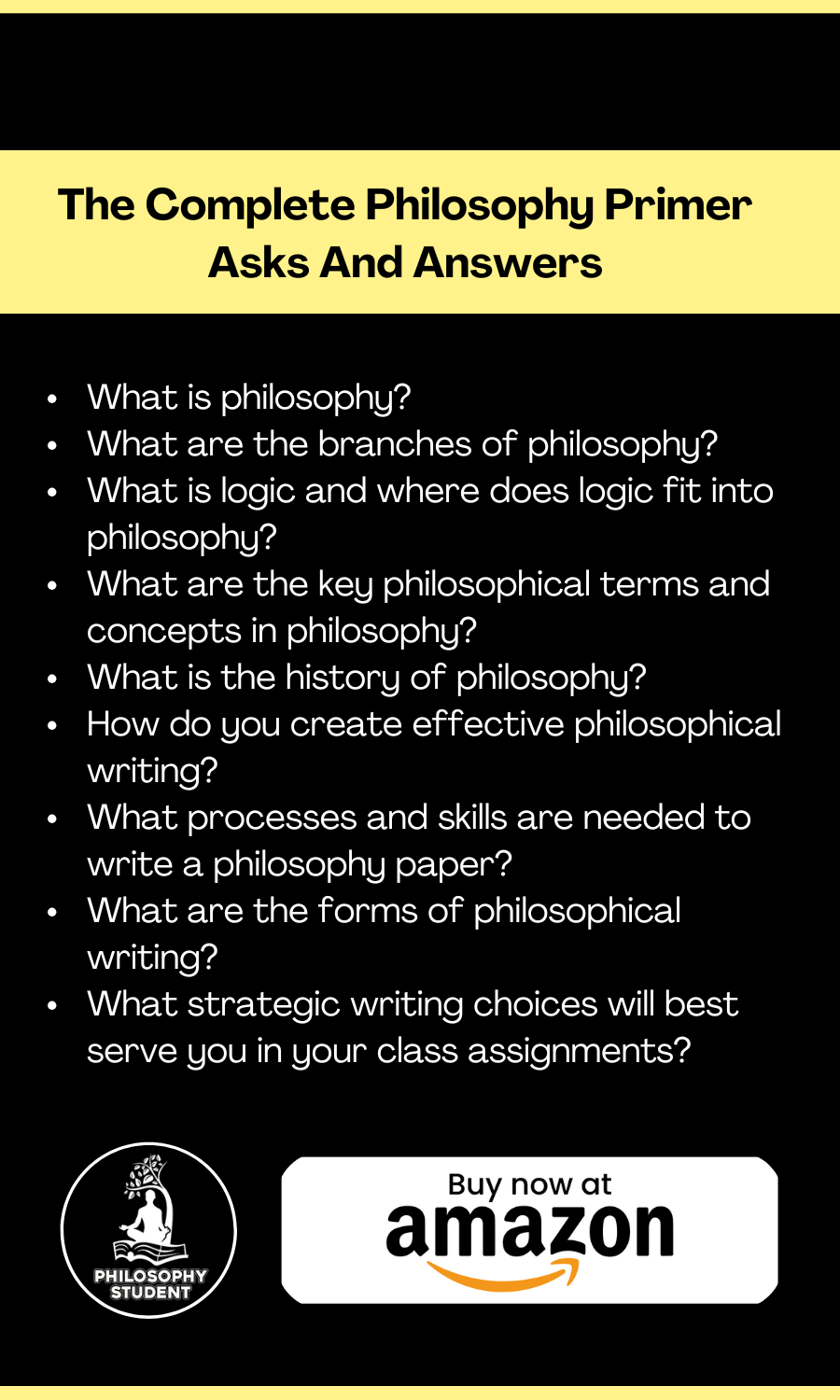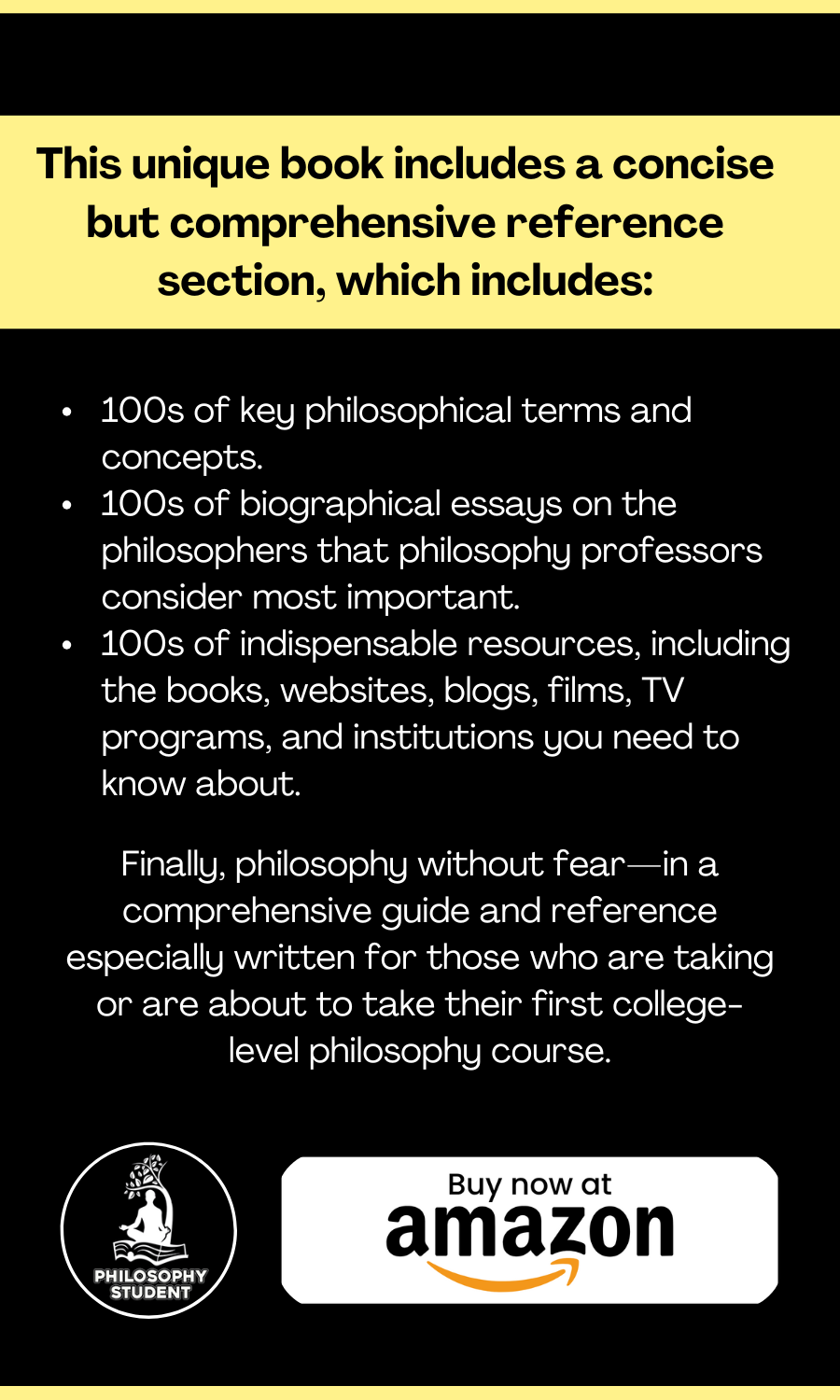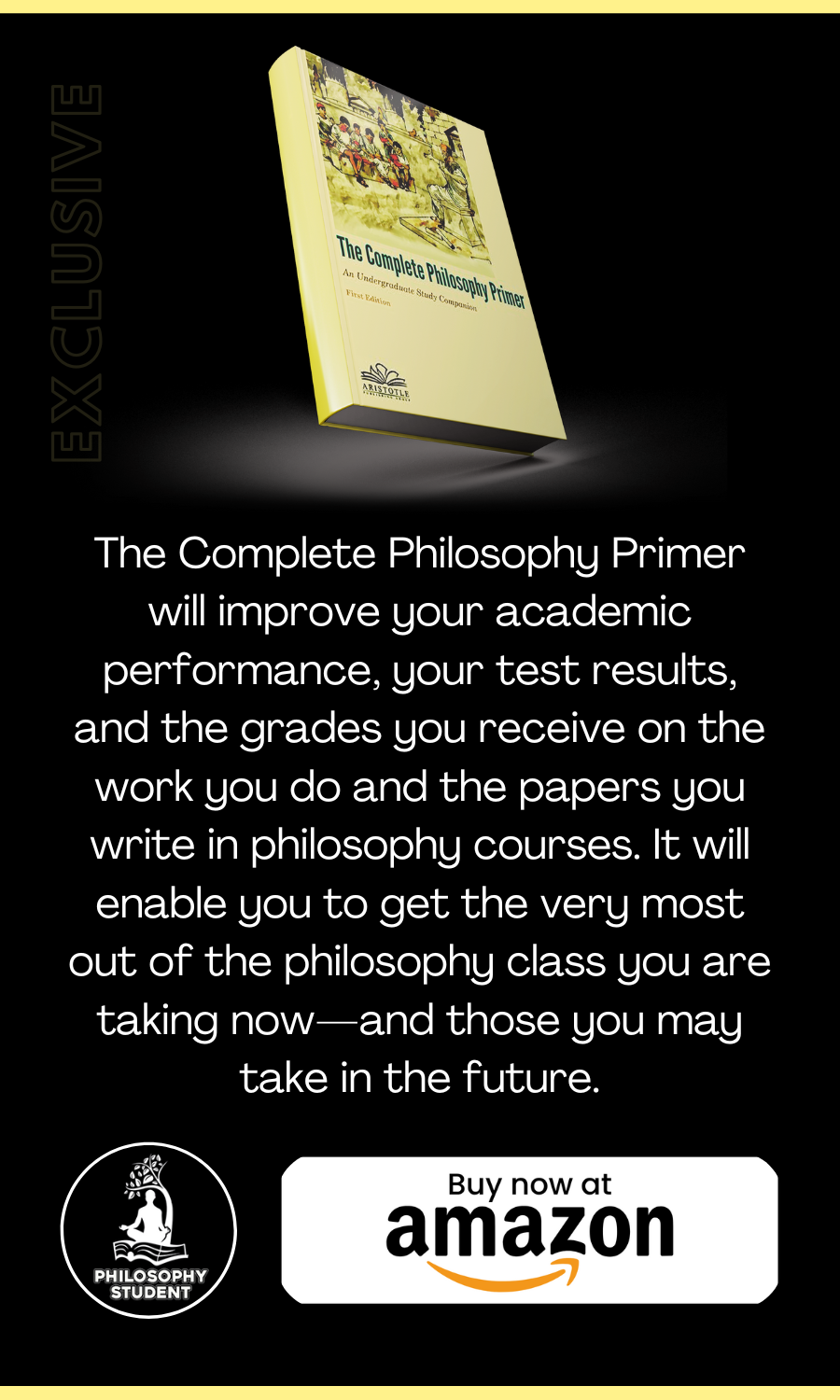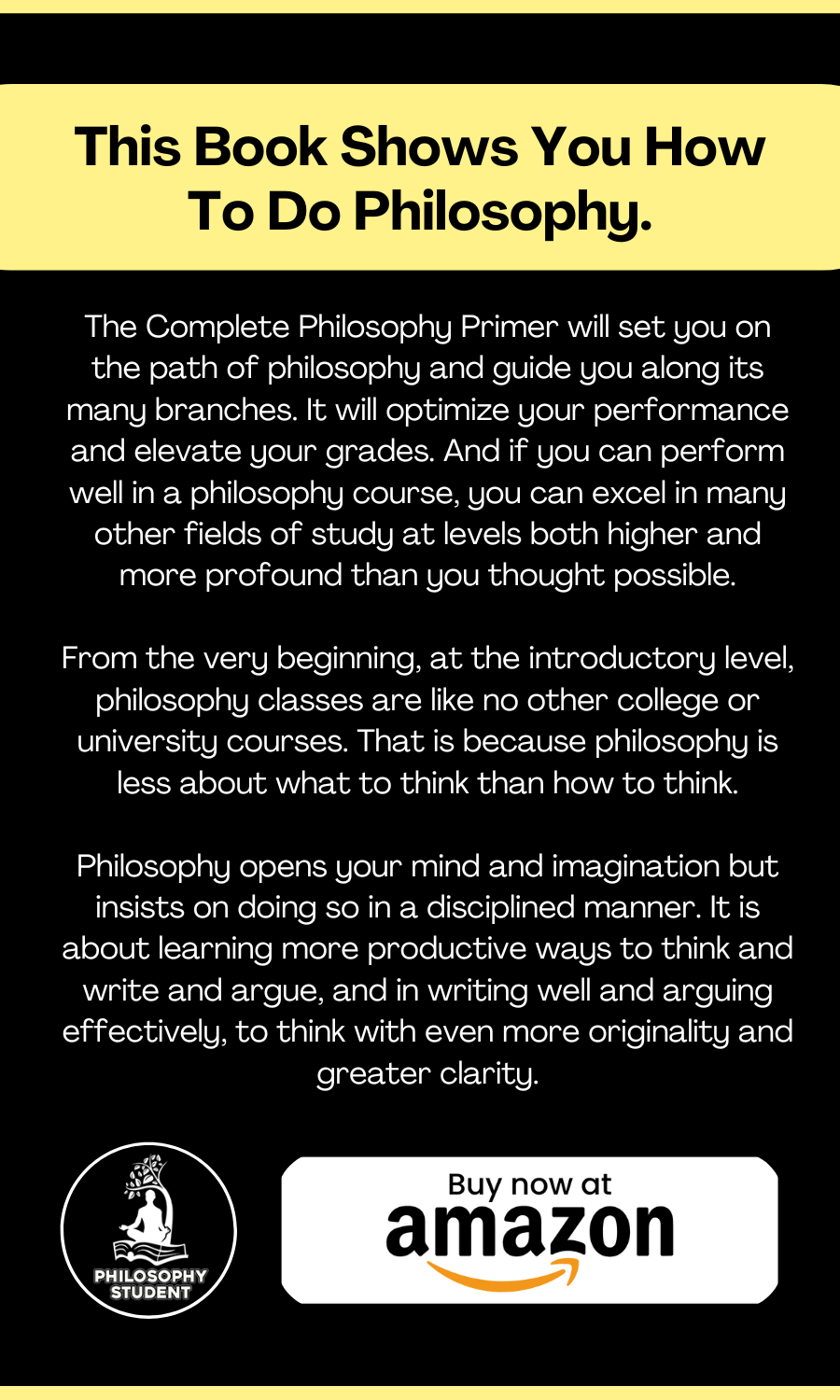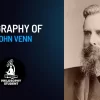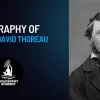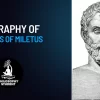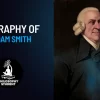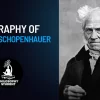Writing is work, and for many of us, writing is hard work. Writing philosophy adds to this labor an element of intimidation. Whether you are writing an expository—explanatory and descriptive—essay or an argumentative essay, writing for a philosophy class has a higher bar than writing in most other academic contexts. You are expected to be precise in word usage, economical in expression, and logical in structure. Since philosophers take nothing for granted, you can expect that your philosophy professor will be unlikely to overlook anything in your work. By the same token, most good instructors do not set out to penalize you for mistakes and missteps. They may not readily overlook them, and they will likely point them out. But they are also unlikely to overlook the positive aspects of your work, the instances of sound argument and precise expression and, especially, the appearance of original thought. So, while philosophical writing assignments may appear to be sown with landmines and booby traps, they are also rich with opportunities to excel
First: Just Get Started
In common usage, inertia refers to a tendency to do nothing and, even more commonly, the difficulty many of us feel to get a project under way. Writers often call this “writer’s block.” Because philosophical writing promises to be more demanding than general writing, it is quite possible that your inertia will be formidable. I have a few suggestions for overcoming it.
Overcoming Inertia (Writer’s Block)
First, go to the physical source of the word inertia, Sir Isaac Newton’s First Law of Motion. In summary, it states that an object either remains at rest or continues to move at a constant velocity unless acted upon by a force. For a writer worried about writer’s block, the metaphorical implication of this is twofold. First, the inertial state of rest is not permanent. It can be overcome by the action of a force—that is, a push. Second, “inertia” is not a synonym for motionlessness. If an object is in motion, inertia is the quality that keeps it in motion. For a writer, this means, once you get going, you tend to keep going.
- What forces can “force” you to get into motion?
- Finding a topic that interests or even excites you, a topic you feel like writing about
- Finding an intellectually or morally important topic
- A competitive need to do well on an essential class assignment
- A dread of failing an essential class assignment
Whichever of these forces you feel (from one to all four), harness them. Let them get you off the dime and into the writing assignment.
Know where you are going to go
Another “force” that will help you move and remain in motion is ensuring that you thoroughly understand the assignment you have been given. If the instructor has given you written directions, follow them. If anything is unclear, ask questions. If instructions are given verbally, take thorough notes. Compare notes with a classmate or two. Again, ask questions about anything that is unclear.
Invention
The ancient Romans worked hard to refine the art of persuasive expression (both oratorical and written) into the discipline called rhetoric. The first step in composition they termed Inventio, which combined the meanings of the modern English words discovery and invention. The great Roman orators recognized that good composition begins with a process that requires both discovering an appropriate topic and inventing approaches to it. That is, a “topic” is both a given subject and the ideas the writer brings to it and extracts from it.
For some assignments, research will constitute the ground on which you search out and discover a topic. For others, even when the instructor gives you a general topic or poses a specific question or problem, you will simply have to generate your own ideas.
Some writers sit and stare at a blank page or a white screen (on which the relentless cursor pulsates), waiting for an idea to hit them. This passive approach can, in fact, invite ideas to come. But under the pressure of a class assignment, with time limited and an assignment due, you may want to try something more proactive.
Freewriting
Freewriting takes literally the notion that thinking is writing and writing, thinking. Instead of just letting ideas come to you, write them as they enter your head. Don’t self-censor. Don’t worry about grammar or spelling. Make sentences if you wish or just spit out phrases or even single words. Put down whatever comes to mind. Some writers find it easier to do this with a pencil or pen on a sheet of paper, but, these days, as more of us have become wedded and welded to keyboards and screens, most writers tap out their thoughts. Whatever technology you use, analog or digital, put the emphasis on free. This material is for your eyes only. Let it flow. And keep writing for as long as the writing comes. When it peters out, stop, make sure you save your work (if you are using a computer), and put it away for an hour or a day. Then come back to it and start mining. Look for the ore from which you will refine a paper.
Looping
A variation on freewriting is sometimes called looping. This imposes a degree of discipline on the freewriting. You free-write for a set amount of time—say five minutes or ten—at the end of which you pause to read what you have written. From this material, you pull out the core of a concept or whatever strikes you as most interesting. You take the time to refine this core into a good sentence that summarizes the theme. This completed, you dive into another five or ten minutes of freewriting, stop, and repeat the extraction and refining process. Keep going, repeating the alternating freewriting and extraction process, as long as it is productive.
Brainstorming
Brainstorming can be done alone or (more often) with others. This differs from freewriting in that it is a deliberate attempt to generate ideas. As with freewriting, don’t censor yourself. The goal is to push out as many ideas as possible. If you are working with others, do not comment on the ideas generated. Just record them.
Class notes and learning journals
There are four kinds of note takers in any class. The first kind are what you might call “the stenographers,” who endeavor to write down every word that comes out of the professor’s mouth. The second kind are “the highlighters,” who try to summarize the most important things that are discussed in class. The third type of note takers are “the thinkers.” These students note the key points raised in class—whether by the instructor or others—but also write down their own thoughts as they occur. In effect, they conduct a kind of dialogue with the others in the class. Sometimes it is a counterpoint.
And the fourth category? It is those who take no notes at all. Good luck with that. The first three note taking styles are all useful, but by far the most effective in a class where essays will be written is “the thinker.” What good reason is there not to use each class session as an opportunity to generate writing ideas?
The learning or class journal
Some professors encourage students to take “the thinker” style a step further by keeping a “learning journal” or “class journal.” This is a collection of notes, observations, and thoughts you compile not during class but after class or maybe even at the end of each week of classes. It is a kind of learning log intended to provide you with a picture of your growing understanding of the subject at hand—in this case, philosophy. It is an opportunity to record ideas that occur to you close to the time that they are formed. The document becomes a record of your evolving understanding and ideas. In addition to providing grist for later writing, the learning journal also helps you to identify your strengths and weaknesses, areas you can exploit in an essay, and areas in which you need more work
The Writting Process
Up to this point in this section, we have been discussing what might be called “prewriting,” the steps taken prior to formally beginning a writing project. The transition from prewriting to writing comes when you have selected your topic.
Selecting a Topic
Assuming that you are not assigned a topic, the first criterion for selecting one is to try to discover a topic that interests you or, even better, excites you. It is far easier to write well about something that engages you mind, your imagination, and your feelings than it is to try to gin up interest in a topic to which, in fact, you are indifferent.
But before you pounce on this labor of love, ensure that it is a topic sufficiently narrow to cover adequately in the space you have. Nothing kills a good topic faster than having to broadly generalize. On the other hand, topics that are too narrow may be insufficiently ambitious to engage your interest—and if you are not engaged, how do you expect to enthrall your reader? Generally, far more novice philosophical writers make the mistake of selecting a topic too broad or general or vague than one that is too narrow.
Another criterion for topic selection is the presence of controversy. If you choose a topic on which everyone generally agrees—say, sexual assault is morally wrong—you will have a very difficult time finding something novel, original, or even interesting to say about it. In short, the reader will ask, Why am I reading this? On the other hand, if you choose such a topic and perversely decide to write a paper opposed to it, you may be putting yourself in a difficult, even impossible, situation. Sexual assault is justified … when, how, and why?
Good topics are often those that naturally have two major opposed points of view, pro and con. These may be in the political, legal, or moral/ethical realms, or you may choose to dive into philosophy itself by identifying a controversial philosophical question: Are mind and body dual or one? Or: Does existence precede essence?
The Thesis Statement
Deciding on a topic is a necessary first step to writing a paper, but it isn’t a sufficient first step. The topic must be followed by a thesis statement, which clearly identifies the main point you want to make about the topic or an argument related to the topic. An effective thesis statement will not only guide your reader through your paper, it will guide you in writing the paper.
Here are some examples of thesis statements capable of launching an effective essay:
- René Descartes’ model of a mind separate from the body is successfully refuted by
- William James’s 1884 essay “What Is an Emotion?”
- The dramatic rise in American populism seen during the 2016 presidential election was overwhelmingly a response to increasing globalization.
- Assisted suicide is both moral and ethical and, therefore, should be protected as a human right.
- Public libraries “promote the general welfare” and should therefore be subsidized by the federal government.
To Outline or Not to Outline?
Some writers create a thorough outline before beginning to draft an essay. Others just dive in. And still others sketch out a basic, rough outline with points that serve as prompts and reminders more than make up a detailed blueprint.
There is no single right answer to the question posed by the subhead above. As you write more papers, you will learn which of the three options works best for you. This said, however, in writing for philosophy class, it is best to try beginning with an outline. Then, after you have finished the whole project—outline and essay—decide whether the outline was worth the effort. The fact is that most philosophical assignments are sufficiently complex that the demands of logical structure require proceeding step by step while also ensuring that you do not forget to include everything important. Ideally, an outline serves as a structural blueprint or a map to get you from Point A to Point F via Points B, C, D, and E. At the very
least, however, an outline can serve as a checklist to ensure that you are covering what must be covered and that you don’t omit anything vital.
Outlines can be invaluable in helping you put your thoughts or main points in order before you begin to write. Let’s say you have decided to write on the mind/body dualism. You jot down the main points you want to cover:
- Embodied cognition (mind-body unity)
- Descartes’ idea of the mind’s relationship to the body as being like that of a “pilot” to the ship he guides
- William James’s idea about the origin of emotion (we do not run because we are afraid;
- we are afraid because we run)
- Plato’s cave analogy
- A rough outline might simply consist of putting these things in logical order:
- Plato’s cave analogy
- Descartes’ idea of the mind’s relationship to the body as being like that of a “pilot” to the ship he guides
- William James’s idea about the origin of emotion (we do not run because we are afraid; we are afraid because we run)
- Embodied cognition (mind-body unity)
This might be enough to get you started on your rough draft. Or you might decide you need to use the more formal traditional outline format, which works like this:
I. First Major Topic
A. First supporting or subordinate point
B. Second supporting or subordinate point
- First subordinate point to point B
- Second subordinate point to point B
a. First subordinate point to point B2
b. Second subordinate point to point B2
II. Second Major Topic
And so on. The utility of the formal outline is that it can prompt or even compel you to work out the logical arrangement of your various points. You decide on your major topics (numbered with roman numerals). Under I. Major Topic go the subpoints that directly support this Major Topic. Under subpoint I.A go the subpoints that directly support I.A. and so on, down the line. In this way, you make your most comprehensive points and support them logically. Here is an example of a formal outline summarizing Descartes’ argument that the mind is more certainly known than the body:
- The mind is more certainly known than the body
A. Perhaps all I know of external objects, including my own body, is false because of the maleficent acts of some demon.
B. But it is not possible that I could be deceived about my existence as a thinking being.
C. Even physical objects, including my body, are known more distinctly through the mind than through the body itself. - Consider the example of wax
a. All properties of a chunk of wax that I can perceive with my senses change as the wax melts.
b. This is also the case with the chunk’s primary properties, such as shape, extension, and size, which exist apart from my own perception of them.
c. Nevertheless, the wax remains the same piece of wax even as it melts. - Therefore, what I know of the wax, I know through my mind (the faculty of judgment) and not through my senses or my imagination, which is fed by my senses.
- Therefore also, every instance of distinct knowledge of physical matter provides certain evidence that I am a thinking being.
- D. In conclusion, I know my mind more clearly and distinctly than I know my body.
When you are faced with having to summarize an orderly argument like this one, it is almost always best to begin with a full formal outline, which shows the relationship between each point and subpoint and sub-subpoint of the argument
Rough Draft
Once you have your thesis statement and whatever form of outline—if any—you have chosen to create, you are ready to write the first draft, which is called a rough draft because it is still very much a work in progress. Some writers create more polished first drafts than others. This does not matter. It is your final draft that counts. In fact, the best strategy is simply to get the writing done. You don’t have to rush through it, but you should not let yourself get bogged down agonizing over each word. Nor should you worry too much about length. Right now, you want to get your thoughts into the form of words, sentences, and paragraphs. If you have been given a strict word count to meet, you can add or cut as part of the work of preparing the final draft. You are not Michelangelo carving in marble. Language is far more malleable than stone, and you can lengthen, shorten, and reshape readily.
Think of the rough draft as your opportunity to see what you are thinking. Allow not only ample time to self-edit and polish your work into a final draft, but make sure you can set the first draft aside at least overnight—preferably for a full twenty-four hours—so that you can come back to the work cooled off from the heat of original composition, with a fresh perspective, and ready to view with a cold eye all that you have written. This cooling-off period between completing the rough draft and starting the final draft is valuable for gaining objectivity on your work. Do not cheat yourself out of it. It will improve your writing
Self-edit, better known as revision
Once you are “cold” from the rough draft, it is time for self-editing. Some writers call this revising, and that is a good word for it. It is all too easy to become wedded to your rough draft and therefore opposed to looking at it objectively. You may be nervous about what you will think on reading your own work. You may be asking yourself, Oh, God! What if this needs revision?
The good news is that you can set your fear aside. The bad news is that your first draft will almost certainly require revision because virtually all first drafts require revision. In fact, most professional writers will tell you that the “real” writing comes in revising the rough draft. Revision is a vital part of the writing process.
Think about the word revision. You don’t need a dictionary. The prefix re-means to “do again,” and vision—well, you know what that means. So, to revise is to re-see or to see again.
- Don’t rush the revision. Give yourself plenty of time reread your draft carefully. Many writers read their own first drafts aloud to themselves. This helps them “hear” their work as others will.
- Correct any typos, spelling, or grammatical errors you find. Fix each as soon as you find it. Some experts advise writers to focus first only on the big stuff and save the details for the proofreading stage. Bad idea. When you find a mistake, just fix it. Now.
- This said, do focus on the big picture. Reread your thesis statement carefully. As you go through the rest of your paper, keep asking yourself: Does what I have written in this sentence and in this paragraph relate to and support my thesis? If you cannot answer yes, you have now identified something requiring revision.
- The big picture also includes structure. Is the progression from section to section (if your paper has sub-headed sections), paragraph to paragraph, and (within each paragraph) sentence to sentence logical? It should be like a set of directions to get from point A to the endpoint—let’s call it point G. Does the paper progress A to B to C to D to E to F to G? Or is something out of order? Do you detect A to C to B? Or is a necessary point missing?
- Check for overall unity. Each part of the essay should relate logically to every other part, to the essay as a whole, and to the thesis. This is not some mystical sense of wholeness. Just ask yourself if anything you say at point D (for instance) contradicts something in A or G. Your essay will likely include counterarguments to your thesis. As long as you deal effectively with these, they are not contradictions. What you must avoid, however, is contradicting yourself and your own thesis.
- Check your transitions. The coherence of your essay, especially when detailing a philosophical argument or concept, requires a seamless progression from point to point. These transitions are aided by verbal signposts, such as however, therefore, fortunately, in any case, nevertheless, and so on. Major transitions require more, often an entire sentence or even a whole paragraph: “To understand the impact of Sartre on existentialism, we must briefly survey existential thought as far back as Kierkegaard.” A sentence like this will explain why everything from, say, point A to point D deals with the twentieth century, but point E is about to take us back to the nineteenth. Such an explanation will prevent the reader from getting lost in time en route to your conclusion. Transitions keep you and your reader on course.
- Look for repetition. In our anxiety to get our main points across, most of us tend to become repetitive. A certain amount of repetition of key points can be quite useful, and your conclusion will likely reprise the highlights of your essay. But relentless repetition is counterproductive. Look for the same points repeatedly made. Jettison some of these.
We don’t just repeat our major ideas. We also often repeat certain words and phrases as well as monotonous sentence constructions. If you are writing in the first person, you are almost certainly overusing the pronoun I. Vary your expressive palette.
All of this said, repetition, used thoughtfully, can be both intellectually and stylistically powerful. Don’t arbitrarily banish it all. Just be certain that when you repeat, you do so for a good reason.
Most word-processing programs include a means of “tracking” changes that you make —edits, additions, deletions, and movement of words, sentences, paragraphs, and sections from one place in the essay to another. Turn on “track changes” and keep it on.
Final Draft
How do you know when your “final” draft is final? When you have passed through the seven steps of revision enumerated above and can answer yes to every question about whether each sentence, paragraph, and section relates to and supports your thesis and creates overall unity free of self-contradiction.
Once you have reached this point, you have what can be called a final draft, with the emphasis, however, on the word “draft.” You have one more crucial step, so do not turn off your word processor’s change-tracking feature yet
Proofread
Set your final draft aside overnight or for at least twenty-four hours. Reread it—yes, again. You are looking for the same errors and wrong turns you were searching for when you read through the rough draft, but, this time, you are also paying close attention to the details of punctuation and spelling. Make use of the tools just about every word processing program provides, both spell-check and grammar check. They are not 100% reliable, but whatever potential problems these checking programs highlight is always worth doublechecking. As you proofread, pay close attention to words you used in the essay but have rarely or never used elsewhere, including the specialized vocabulary of philosophy. Don’t assume or
guess that you understand these words unless you are certain that you do. Resolve any doubt by looking them up. The same goes for any items of research. Doublecheck references to dates, people, places, book titles, and the like.
Before you turn off “track changes” in your word processor and irrevocably “accept” all the edits you have made, examine the deletions you have made. Are all of them intentional? Or was something deleted by accident? Now is the time to doublecheck. This said, storage space on personal computers is cheap and plentiful—and the cloud offers virtually boundless digital real estate. Before you accept all your edits and finalize them, save under a distinctive file name a copy of your essay with all edits fully tracked and preserved. After you have done this, accept all your changes and turn off the tracking feature. It is, however, a good idea to scroll or click through each full page of your work to make certain that paragraphing, paragraph indents, and spacing all look correct. These often get out of whack when you work with the change-tracking feature turned on
Publish
The final step is the same for you as it is for professional philosophers: publish. Philosophical writing is intended to be shared with others. Practicing philosophers seek publication in the professional journals read by other philosophers, just as scientists seek publication in the scientific journals that are important to colleagues in their discipline. As a student in a philosophy course, “publication” may consist of nothing more than handing in your work, on paper or online. In some courses, essays are posted online for everyone in the class to access and even comment on. Either way, recognize this last step as much more than a course requirement. It is the way of a philosopher.




